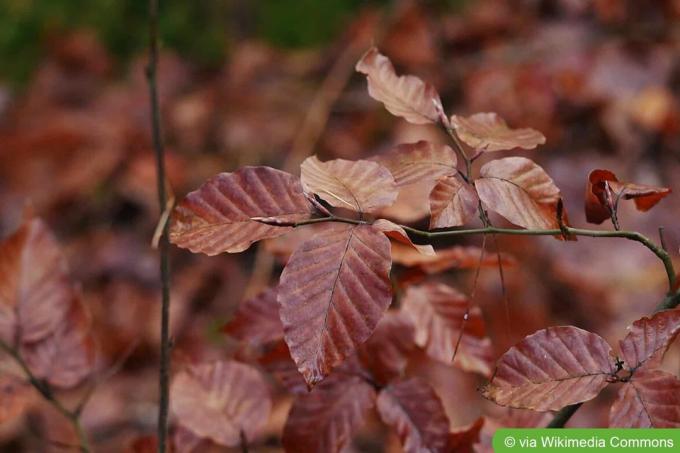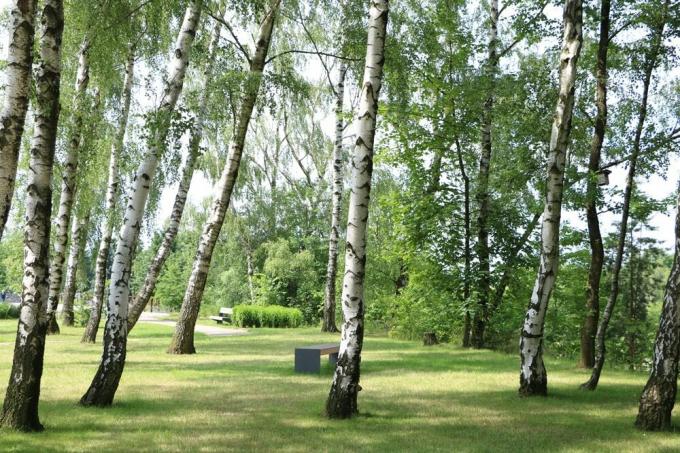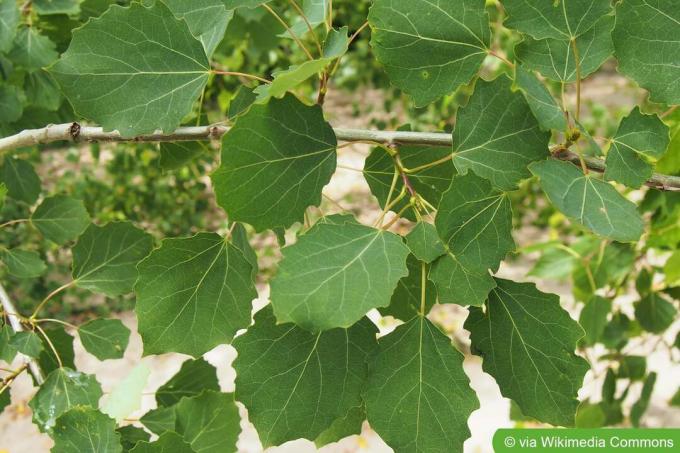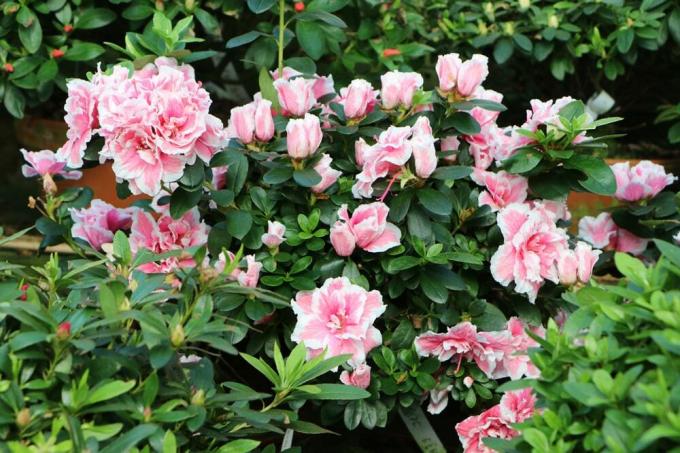

Table of contents
- Tree leaves determine from B to E
- F to R
- Leaves of trees with S
- Tree leaves from W to Z
Admiration of a magnificent tree goes hand in hand with the desire to call the species by its name. An important indicator for species identification is the shape of the leaves. Size, shape, perforation and arrangement provide valuable information and help to determine the right tree species. The characteristics of different tree leaves for identification are compiled here.
Tree leaves determine from B to E
Sycamore maple, forest maple (Acer pseudoplatanus)
Sycamore can be recognized by its 5-lobed, bluntly serrated leaves. The foliage is dark green on top. Underside the coloring tends towards grey-green. The most striking difference to Norway maple are the rounded tips of the leaves. The front three leaf lobes are usually the same size. In contrast, the two lower lobes are smaller and not always fully developed.

- Arrangement: opposite
- Size: 14 to 16 cm long
- autumn coloring: yellow-orange
beech, red beech (Fagus sylvatica)
Leaves of a beech are silky hairy for some time after they have sprouted. In the course of summer, the tops of the leaves become bare and dark green. Overall, the ovate leaves take on a leathery consistency. A light green color and loose to dense hairs dominate on the underside of the blade. The long, wonderfully silky cilia that adorn the slightly toothed, sometimes wavy edge of the leaf are striking. At 1.5 cm, the petiole is comparatively short.

- Arrangement: alternate
- Size: 5 to 10 cm long and 3 to 7 cm wide
- autumn coloring: yellowish to reddish brown
Ash, Tall Ash (Fraxinus excelsior)
The ash tree with its picturesque foliage is a welcome guest in large gardens and parks. The distinctive shape of the pinnate leaves makes it easy for even the untrained eye to identify the tree without a doubt. An ash leaf is imparipinnate with 9 to 15 individual leaves. An ovate to lanceolate leaflet is 4 to 10 cm long and 1.5 to 4 cm wide. Leaf margins are serrated sharply. Side leaves are on a slightly shorter petiole than end leaves. In contrast to the fresh green upper side, the underside comes in a lighter shade of green. The leaf spindle itself has a petiole up to 10 cm long.

- Arrangement: crosswise opposite
- Size: 25 to 40 cm long
- autumn coloring: no
Chestnut, sweet chestnut, chestnut (Castanea sativa)
At the end of April, the sweet chestnut sprout slightly hairy leaves that quickly become bare. The two 1.5 cm short stipules at the base of the leaf also only act as a distinguishing feature for a short time and fall off within a few weeks. In the meantime, the widespread tree has completed its dense foliage, which consists of long, elliptically shaped leaves with a short leaf tip. Each leaf is serrated along the margin, with the teeth terminating in a tiny forward point. The upper side of the leaves is deep green and glossy. The underside of the leaf is lighter and traversed by 12 to 20 pairs of veins that stand out clearly.

- Arrangement: alternate
- Size: 12 to 20 cm long, 3 to 6 cm wide
- autumn coloring: dark yellow
F to R
Field maple, Maßholder (Acer campestre)
A field maple leaf is characterized by rounded or blunt-edged leaf lobes. A leaf is divided into 5 lobes and stands on a stalk up to 6 cm long. The upper side of the leaf is matt dark green, while the underside of the leaf shines in a lighter shade of green. It is characteristic of the popular maple species that dead tree leaves remain hanging in sheltered locations well into winter.

- Arrangement: opposite
- Size: 5 to 8 cm long, 8 to 10 cm wide
- autumn coloring: bright yellow to orange
hangingbirch, silver birch, silver birch (Betula pendula)

You can recognize the most important pioneer tree in Germany by its long, pointed, triangular to diamond-shaped leaves, which stand on 3 cm short stalks. A double-sawn edge is striking. If you pick up a leaf, you will notice how thin it is and how bare it is on both sides. Shortly after budding, the foliage is often slightly sticky.
- Arrangement: alternate
- Size: 4 to 7 cm long and 2 to 3 cm wide
- autumn coloring: golden yellow
Hornbeam, hornbeam, hornbeam (Carpinus betulus)
A hornbeam leaf is medium to dark green, ovate, and pointed at the top. As a rule, the base is pointed, rounded or truncated, rarely a little crooked. What catches the eye are primarily 10 to 15 parallel, pronounced leaf veins, which make a leaf appear as if it were folded. The leaves are initially sparsely hairy on the underside, later bare. The coloring on the upper side is dark green. When you turn a leaf, a light green underside appears.

- Arrangement: alternate
- Size: 4 to 10 cm long, 2 to 4 cm wide
- autumn coloring: yellowish
Horse Chestnut, Common Horse Chestnut, White Horse Chestnut (Aesculus hippocastanum)
With finger-shaped leaves, the horse chestnut gives the first clues to its identity. One leaf is dull green and bare on top. On the underside, a light green with felt-like veins characterizes the visual appearance. There are 5 to 7 individual, narrow pinnate leaves that gather to form a large horse chestnut leaf. A single leaflet can grow up to 18 cm long and 10 cm wide. The petiole, where all the pinnate leaves meet, is 10 to 15 cm long. Also characteristic are the double-sawn edges and a wedge-shaped, slimmer base.

- Arrangement: alternate
- Size: 25 to 30 cm
- autumn coloring: yellow to orange
Leaves of trees with S
sal willow, kitten willow(Salix caprea)
The leaf of a sal willow can be shaped from elliptical to round. Significant features are sunken leaf veins and a serrated edge. Furthermore, the leaves only start to sprout after the catkins have flowered. The elliptical blade shape ends in a short, blunt, slightly twisted blade tip. The green upper side of the young foliage is characterized by a slight hairiness. The short hairs fall off as the leaves develop, revealing a dark green, shiny surface. The underside of a sal willow leaf is blue-green and has permanently felty-white hairs. Small, half-kidney-shaped stipules that sprout at the base of the leaf clear up any remaining doubts about the tree's purpose.

- Arrangement: alternate
- Size: 5 to 7 cm long, 2.5 to 4 cm wide
- autumn coloring: yellow-brown
Silver Poplar, White Poplar (Populus alba)
When the summer wind blows through the crown of a silver poplar, the foliage shimmers silvery white. The reason for the picturesque spectacle is a combination of light green leaf tops and felty-white, woolly undersides. Only when sprouting are the tops hairy, later bare. The white poplar can be reliably identified using a sinuous, 3 to 5-lobed leaf shape with notched edges on a 2 to 5 cm long stalk. In outline, the tree leaves appear triangular-oval to rounded with a truncated base.

- Arrangement: alternate
- Size: 5 to 10 cm long, 3 to 5 cm wide
- autumn coloring: yellowish
Tip:
With a more or less pronounced hairiness on their leaves, trees protect themselves against a variety of dangers. The denser the hair coat, the less water is evaporated. On young leaves, the hairy protective layer prevents damage from sunburn because it refracts the light. Last but not least, a woolly patina prevents cunning aphids and other pests from attacking the tree leaves.
Norway maple (Acer platanoides)
Norway maple owes its name to perfectly shaped leaves with round incisions and pointed teeth. The number of entire leaf lobes varies. Bays between the 5 to 7 lobes are always blunt. A petiole up to 20 cm long with a spherical base is striking. The best-known variety is "Globosum", whose spherical crown features hand-shaped, 5-lobed leaves.

- Arrangement: opposite
- Size: up to 20 cm long and wide
- autumn coloring: in many intense colors
English oak, German oak (Quercus robur)

An irregularly indented leaf edge with small "ears" at the end of the stem characterizes the foliage of a common oak. The petiole itself is very short at 1 cm. The sheet is wider above the middle than in the lower half. A leaf is shiny deep green on the upper side in summer and a little lighter on the underside. If you run your finger over the underside of the leaf, you will feel the leaf veins that are slightly hairy.
- Arrangement: alternate
- Size: 10 to 15 cm long
- autumn coloring: yellow-brown
Small-leaved lime (Tilia platyphyllos)
The widespread tree can be identified by its heart-shaped leaves with a distinctively long, slender tip. These are 10 to 15 cm long and wide. The leaf edge is slightly serrated. A characteristic feature is extremely fine hairs on the fresh green upper side of the leaves when they sprout. You can see and feel fluffy soft hairs on the leaf veins, which thicken into whitish tufts of hair in the nerve axils.
- Arrangement: alternate
- Size: 10 to 15 cm long and wide
- autumn coloring: golden yellow

Tree leaves from W to Z
small-leaved lime, stone lime (Tilia cordata)
If you want to determine the tree of the year 2016 and clearly distinguish it from the small-leaved lime, take a look at the tufts of hair (domatia) on the undersides of the leaves. On a small-leaf linden, domatia are always brown in color and positioned at the corners of the main and lateral veins. Furthermore, the heart-shaped leaves are slightly smaller at 5 to 7 cm than those of the conspecific. Dark green, bare and elegantly shiny, the tops of the leaves thrive. The foliage is bluish-green on the underside. The leaf margin is finely serrated.
- Arrangement: alternate
- Size: 5 to 7 cm long and wide
- autumn coloring: yellow
Walnut tree, real walnut, tree nut (Juglans regia)
Imposing pinnate leaves are among the outstanding attributes of a real walnut. Thanks to an elegant shape of the foliage, you can see the widespread deciduous tree even without its crunchy nuts. Each walnut leaf is imparipinnate with 5 to 9 leaflets. A single leaflet is dark green, 6 to 12 cm long and 3 to 6 cm wide and entire. The terminal leaflet is always larger than the side leaflets. Except for underarm armpits, the leaflets are hairless. An aromatic scent spreads when you rub the leaves between your fingers.

- Arrangement: alternate
- Size: 30 to 40 cm
- autumn coloring: yellowish-brown to yellow-orange
Quaking poplar, aspen (Populus tremula)
The circular leaf blades with a pointed tip are characteristic of the aspen. When they sprout, the single-toothed leaf is conspicuously felt-like and bluish in color underneath. The slightly flattened petiole is 3 to 8 cm long. Due to this property, the foliage trembles even with a light wind, hence the expression "trembles like an aspen leaf".

- Arrangement: alternate
- Size: 3 to 10 cm in diameter
- autumn coloring: pale green to golden yellow
 garden editorial
garden editorial I write about everything that interests me in my garden.
Learn more about shrubs and woody plants

17 flowering hardy plants May to October
Many plants only show their full splendor for a short time. But there are also types and varieties with a particularly long flowering period from May to October, sometimes even longer. We present 17 flowering hardy plants.

25 hardy and evergreen ornamental trees
Ornamental trees are among the most popular plants in the garden. They have a decorative effect and set special accents in the green oasis. If you are tired of the gray of the cold season, you can plant trees that are hardy and evergreen.

Is barberry poisonous? | What is to be considered?
With their dense growth, numerous thorns and evergreen foliage, barberries are one of the most popular types of plants for a hedge in the garden. Before cultivating the sour thorn family (Berberidaceae), many ask themselves whether the plant is poisonous.

Azalea location: 6 important criteria
Azaleas are a flowering addition to the garden or living room, as long as they are in the right location. In the following guide to azaleas, we will tell you what to look out for.

How fast does a rhododendron grow? | Information about growth
How fast a rhododendron grows depends on various factors, including the variety, location and care. Growth can be accelerated under optimal conditions, while deficiencies lead to stunted growth.

Butterfly bush: the ideal location | Buddleia
The uncomplicated, easy-care and robust butterfly bush is suitable in the garden for borders, a flowering hedge or as a solitaire. Dwarf summer lilacs are ideal for pot culture. Buddleia bloom from June to October and are a magnet for many butterflies.


